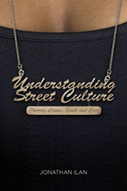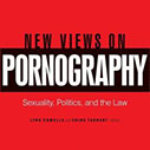Understanding Street Culture: Poverty, Crime, Youth and Cool

Author: Jonathan Ilan
Publisher: Houndmills, Basingstoke, Hampshire, UK; New York: Palgrave Macmillan, 2015. 216p.
Reviewer: Lorine A. Hughes | May 2016
Understanding Street Culture advances a conceptual framework to help explain the nature, causes, and consequences of urban street culture on a global scale. Starting with observed similarities between street cultures across the world, author Jonathan Ilan points to social, economic, and cultural exclusion as the common thread linking disadvantaged urban populations in “the adoption of particular values, concerns and practices, which facilitate survival and a culturally mediated notion of success” (p. 3). Included in the content of this “universal” street culture are contemporary versions of Walter Miller’s (1958) “focal concerns”: survival, the illicit economy, respect, antipathy to state authority, collectivism and community, consumerism and distinction, and hedonism and the visceral (pp. 14-16).
According to Ilan, street culture shares much in common with mainstream culture, except the former “entails attempting to flourish within a lifeworld that is distinctly subordinate to the lifeworld of the included” and differs in the “status of participants and the opportunities and strategies available to them” (p. 35). Street culture thus is more accurately described as a form of defiance, rather than political resistance, an “embodiment of frustration and discontent, fleeting emotional satisfactions and refusal to obey normative imperatives” (p. 152). At one end of the street culture spectrum are populations disadvantaged by intersecting configurations of class, gender, and race/ethnicity, and for whom street culture is a means by which to cope with “the material deprivations and cultural subjugation that result from their position” (p. 54). Depending to some degree on individual choice, which is more emotional than rational, and the demands of the immediate situation, which are heavily culturally mediated, these people tend to be the most strongly devoted to street culture and its associated practices, such as stealing, dealing drugs, deploying violence, and distrusting and defying the police. Thus, while street culture may serve important functions for excluded persons, it also helps to reproduce the very social structure by which they are disadvantaged. At the opposite end of the spectrum, included youth adopt leisure-oriented elements of street culture in order to be “cool,” projecting an image imitated ironically from devalued populations and commercialized for consumption outside ghetto contexts. In between these two extremes are people who resemble Anderson’s (1999) “decent” families, in that they embrace street culture to the extent necessary to coexist with street culture adherents. These individuals may go along for excitement and opportunities to make money, but their behavior comes to be defined as criminal, more so because of who they are and what is happening in the moment (e.g., a group of young males hanging out in the streets) than because they inflict any real harm.
A major strength of Understanding Street Culture is that it integrates theoretical perspectives across multiple levels of explanation. At the macro-structural level, it explains the development of street culture as a function of strain in a Mertonian sense; except the subculture of the excluded is not much different from the mainstream in terms of how much wealth acquisition and consumerism are emphasized. The most important contribution of the book occurs at the meso-level, where Ilan addresses diversity in manifestations of street culture and its influence beyond inner-city America. Echoing scholars before him, Ilan contends that structural deprivations and neglect, if not violent repression, of the poor by official forms of governance, especially the police, spawn a normative system that runs parallel to, if not in conflict with, the dominant “neoliberal” social order – e.g., code of the street (Anderson 1999), oppositional street culture (Bourgois 1995), lower class culture (Miller 1958), delinquent subculture (Cohen 1955), street socialization (Vigil 1988), and underclass culture (Wilson 1997). To this he adds a global dimension, noting how urban change and gentrification, population flows, and advancing media technologies have altered traditional notions of space and helped diffuse street cultural elements worldwide. Given the strong similarity between mainstream and street cultures, he “challenges the notion that street cultural expression is an entirely authentic form of cultural production harnessed by the mainstream industries” (p. 37) and parts company with scholars who interpret criminal acts and cool lifestyles in terms of political resistance (e.g., Hagedorn 2008). He also decries the use of the term “gang,” arguing it is outdated and less able than his conceptualization of a street culture spectrum to distinguish between criminal groups across developed and developing worlds. Finally, at the individual level, Ilan bridges agency with structure using Pierre Bourdieu’s (1990) concept of “habitus,” comprised of the “dispositions, habits and instincts that form in a person over time” (p. 57). Shaped to a large degree by class, gender, race/ethnicity, and culture, a person’s habitus affects his/her interpretation of the streets and ability to acquire “street capital,” defined as cultural competencies that bear clear advantages in the streets. Although human emotions introduce a measure of complexity and unpredictability, adhering to street culture seems to become second nature to the excluded, a way of making “the most of opportunities for material gain, pleasure and worth that individuals feel are realistically available to them” (p. 57, emphasis in original). Included individuals are far more likely to perform street culture, with stylistic elements (e.g., speech, clothing, etc.) largely disconnected from criminal and violent substance. According to Ilan, this is “an option that the consumer culture makes available to a broad market” (p. 58).
There is nothing inherently controversial in Understanding Street Culture, at least not to the sociologically-minded student of urban poverty and crime. However, readers may be disappointed by the lack of empirical data analysis. Although Ilan has conducted ethnographic research in previous studies of inner-city life in Dublin, Ireland, and advocates for the method as an invaluable tool for capturing “the immediacy, pressures and visceral satisfactions of street life” (p. 175), virtually no direct observations are shared in the text. This is to be expected, given Ilan’s focus on integration of varied literatures for the purpose of theoretical explanation, but the omission tends to limit the novelty and persuasiveness of his contribution, particularly since supporting evidence often consists of work likewise criticized for lack of systematic data analysis.
One of the more forceful claims Ilan makes is that the term “gang” should be eliminated from serious academic discourse because it is outdated and imprecise, focusing on territorialism at a time when spatial boundaries are increasingly porous and traversed, neglecting the fluidity of street identities, being applied too broadly and across divergent phenomena, and assuming incorrectly that street gang culture is oppositional. Instead of talking about “the gang,” Ilan argues, analysis should focus on “the fluid youth petty-offending group; the loose friendship group which holds individuals who occasionally petty-offend; the provisionally structured territorial and entrepreneurial drug-selling group; the criminally and politically active street cultural institution, etc., indeed, even ‘the true street gang’ (the term used by Hagedorn, 2008)” (p. 81). While the term “gang” certainly comes with a great deal of baggage and imprecision, Ilan fails to make clear how abandoning it in favor of “street culture” will improve our ability to differentiate among the diverse array of existing street groups, including gangs, and understand group identity and the behavioral effects of group processes. I find it easier to accept the more modest claim that street culture is one of several crucially important dimensions to consider in typologizing gangs and capturing similarities and differences that exist in the nature and behaviors of street groups as spatially distinct as bands of “armed young men” in South American slums (Hagedorn 2008), the politically-oriented Almighty Latin King and Queen Nation observed by Brotherton (2008) in New York, institutionalized gangs such as the Vice Lords and Gangster Disciples in Chicago, and hybrid and emerging street gangs elsewhere in the world.
Despite limitations, Understanding Street Culture is an important book that weaves together varied literatures to address a (sub)cultural component frequently missing in discussions of urban poverty, youth, gangs, and crime. Breaking with traditional analyses dominated by structural and behavioral considerations, it explains how global forces intersect with regional and local realities to produce a street culture that is at once concentrated and diffuse, instrumental and expressive, cause and consequence of marginalization, and criminalized and cool. Although some will be unpersuaded by arguments concerning the term “gang” and will want more data, perhaps even further consideration of individual agency, there is no question that Ilan has succeeded in meeting his objectives to “provide a single space from which to continue these debates; to set out and theorize what we know; and to raise questions that will be useful as part of future research agendas” (p. 5).
References
Anderson, Elijah. 1999. Code of the Street: Decency, Violence, and the Moral Life of the Inner City. New York: W.W. Norton & Company.
Bourdieu, Pierre. 1990. The Logic of Practice. Stanford: Stanford University Press.
Bourgois, Phillipe. 1995. In Search of Respect: Selling Crack in El Barrio. Cambridge, UK: Cambridge University Press.
Brotherton, David C. and Luis Barrios. 2004. The Almighty Latin King and Queen Nation: Street Politics and the Transformation of a New York City Gang. New York: Columbia University Press.
Cohen, Albert K. 1955. Delinquent Boys: The Culture of the Gang. Glencoe, IL: The Free Press.
Hagedorn, John M. 2008. A World of Gangs: Armed Young Men and Gangsta Culture. Minneapolis: University of Minnesota Press.
Miller, Walter B. 1958. “Lower Class Culture as a Generating Milieu of Gang Delinquency.” Journal of Social Issues 23(3): 5-19.
Vigil, James D. 1988. Barrio Gangs: Street Life and Identity in Southern California. Austin, TX: University of Texas Press.
Wilson, William J. 1997. When Work Disappears: The World of the New Urban Poor. New York: Vintage Books.
Lorine A. Hughes, Associate Professor, University of Colorado Denver


